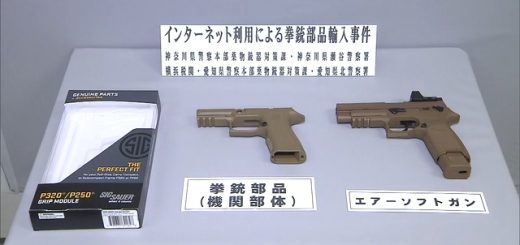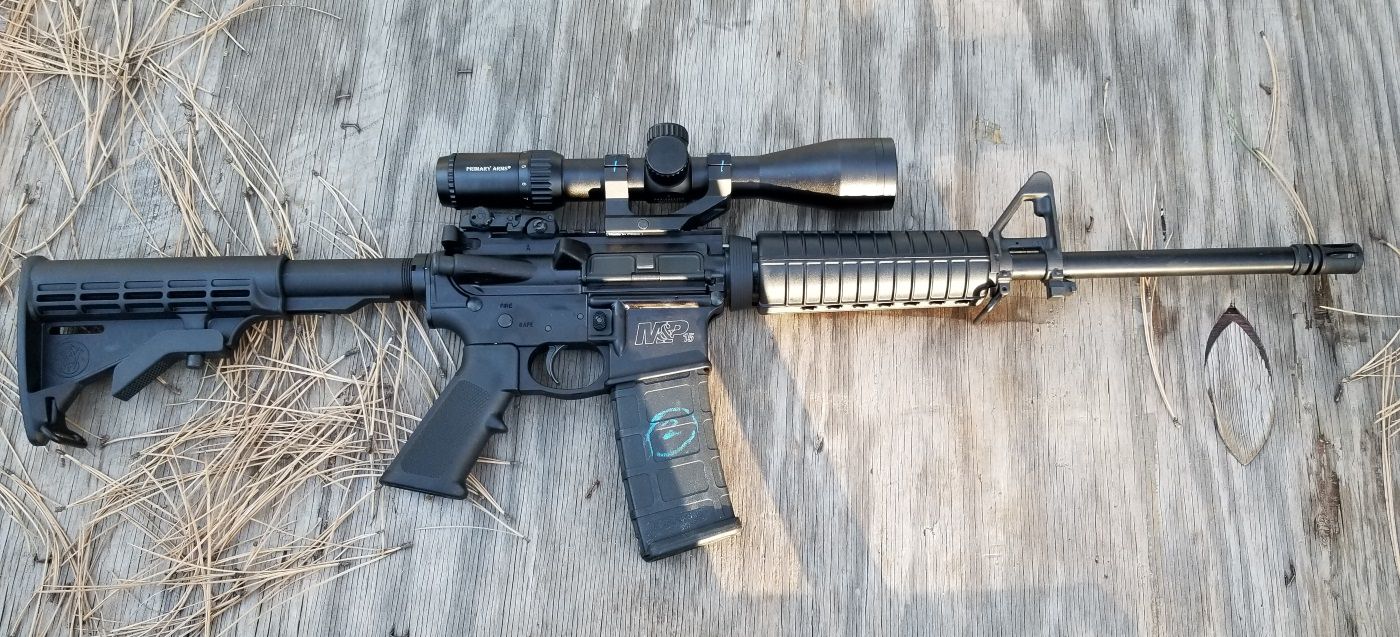The M4A1 Block I: Function Over Form
When I set out to write the Glock Article, I did it solely on one idea. One.
A bet to myself.
You get that urge when you do something every so often to challenge yourself, regardless of what it is. A mental desire to do something utterly inane and useless, but you want to do it so you say you can and did. And writing about the firearm that most people ignore for being boring was that sort of challenge, and so now the question becomes, can I do it again? What other firearm works in the exact same way, so banal and boring you don’t think about it.
Then it hit me.
The AR-15. More specifically, the modern AR-15 version we all know and love, and the one most people think of in regards to anything from a police agency to a SWAT team or the US Military. The M4A1.
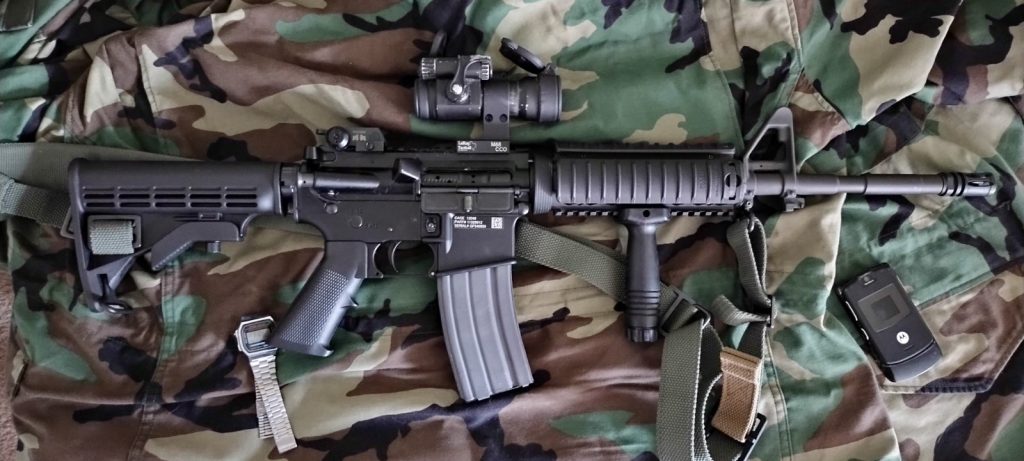
Now, there’s a lot of ways you could spin building an M4A1 in this day and age. You can go retro with millions of sub variants of Colt carbines that means you’re going to get an NDS upper, mix and match parts and claim it’s authentic to some no-digit Colt code from a forgotten trial in the late 70’s. You could go hyper modern, Block II or bust with a 14.5″ barrel, midlength gas system and going onto AR-15 Nation’s Facebook page to partake in the annual cloner group jerkathon. But no. Today we’re going basic. Dumber than dirt. Simpler than Sadie. The M4 that says “I’ve just robbed a National Guard Armory and there’s no law enforcement in the area that can stop me.” We’re talking about the Block I.
But why? Why choose the M4 variant no one cares about? It’s the most boring for sure, 20 years old and still serving a duty that many rifles have tried to beat it at. But then again, there’s a bit of intrigue to that. The M4A1 Block I pattern has been in usage since around 2001. Think about all of the other major rifles of the world that’ve been around for that span of time.
The French have given up the FAMAS after decades of attempted improvements in favor of a 416 pattern rifle, a rifle built to be a “better’ M4A1. The Germans have tried and failed to maintain the G36 platform, and are currently frothing at the mouths over the CA223. The Russians have gone through several overly complex rifle platforms to replace the AK-74M, opting for the most boring option possible of “An AK-74 but with rails and an AR buffer tube”. The British managed to unfuck the L85 by making H&K do it for them. And during all of this, we still use Block I’s. This thing. A rifle platform that, bar a PEQ-15 and folding sights is the same basic rifle platform we were using in Kosovo. How.
I Can’t Get No Satisfaction
1965 was a good year to be a member of Colt Firearms Company. After years of aimless 1911 sales, they had bought the patents to the AR-15 from ArmaLite, initially intending to sell it alongside other products as part of a new line of modern military arms. And, courtesy of the failing M14 project to meet production quota times, they did. Curtis LeMay, Chief of Staff for the new United States Air Force, annoyed by his force still using WWII vintage M1 Garands elected to side step them and adopt the rifles himself. Adopting the Colt Model 604 as the “M16”, his choice would begin a minor schism in the United States Armed Forces overall. While the concept of the AR-15 and early M16’s was derived by a request by US Army General Williard Wyman for a lightweight .223~ caliber rifle, it grated with other generals who had liked the “stopping power” of the 7.62 NATO cartridge and the M14. And these generals would go to many lengths to keep their M14’s in service, even as more and more testimonials from soldiers came back glowing about this new rifle. While in-general US Military reports came back glowing in regards to the AR-15, Army reports didn’t, citing issues with accuracy and damage over long ranges. Investigations into this found that these generals were skewing the reports, supplying match ammo to their control group M14’s and giving tests that’d take advantage more-so of the 7.62 NATO then the .223.

ARPA, who had sent the rifles to Vietnam in the first place drew up a 55 page report about the rifle’s performance in the country, and it was beginning to mount into a schism within the US Military. This schism would be met by the most stern, fact-checked man in American history. Secretary of Defense Robert McNamara. The man behind the Ford Falcon had noticed the schism, and had a good excuse to crack it in half. Citing the missed production quotas from DoD reports, in January of 1963 Robert McNamara would have the M14 program stopped, Springfield Armory shut down and the M16 pushed into widespread testing by the US Military properly. Thus the M16 was born, and those same vindictive generals would continue to undermine the rifle going forward through the XM16E1 and it’s various issues. When I do get my hands on an M16A1, you’ll hear about these in more detail. Because parallel development was still happening at Colt.
Colt wouldn’t just take the adoption of the M16 at face value, and began experimenting with the rifle’s core concepts around the same time. The grand advantage of the AR-15’s modularity, allowing for a variety of parts to be bolted, screwed or fitted to the receiver gave Colt a myriad of options to explore going forward. And those options would become a whole host of various different kooky versions. Some were a tad too wild, such as belt feed conversions, making the AR-15 into a GPMG or LMG. There were heavy barreled models, precursors to the Colt LMG of the 1970’s and 80’s. The most interesting were the short carbine versions. Initially known as the Model 605A, the CAR-15 Carbine at first was a shortened gas system and stock, similar to a modern Dissipator. It would develop the concept of a snubby version of the AR-15, later copied by the AR-15 “Tanker Model” as Colt’s brochures put it.
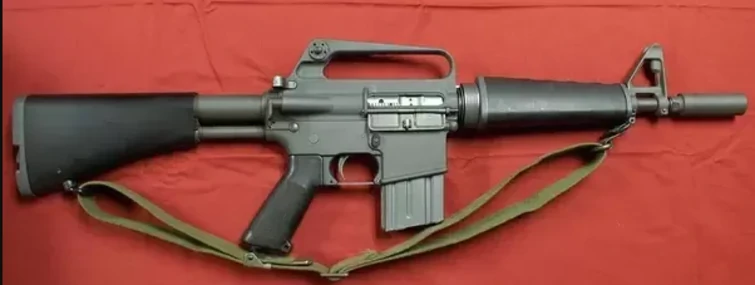
The Colt Model 607, dubbed the “CAR-15 Submachine Gun” would explore the concept further, marrying a short barrel to an AR-15 receiver alongside a collapsing stock instead of a full one, although at first this stock was shaped like the original M16 style stock. Testing with United States Navy SEALs would begin in 1964, and while the rifle was liked for it’s small size in a combat zone as close ranged as Vietnam, there were some faults. Muzzle blast from the short barrel was loud and aggressive, harsh in the tight confines of the jungle, solved with a modified 3.5 inch moderator. This was later swapped as well, as it caused tracer rounds to wildly jaw out of the barrel, and so would the stock. Originally a cut down version of the M16A1’s stock fitted to a sliding assembly with two positions, it was found fragile and prone to breaking in the field. Colt engineer Rob Roy would develop a slim and simplified aluminum stock, creating the iconic CAR-15 buttstock. They would also swap out the 607’s cut down triangular handguards with a cylindrical round one, easing logistics and making another improvement to the design. These improvements would be lumped into two models, the Colt Model 609 with a forward assist and a Model 610 without. These would become what are more commonly known as the XM177’s.
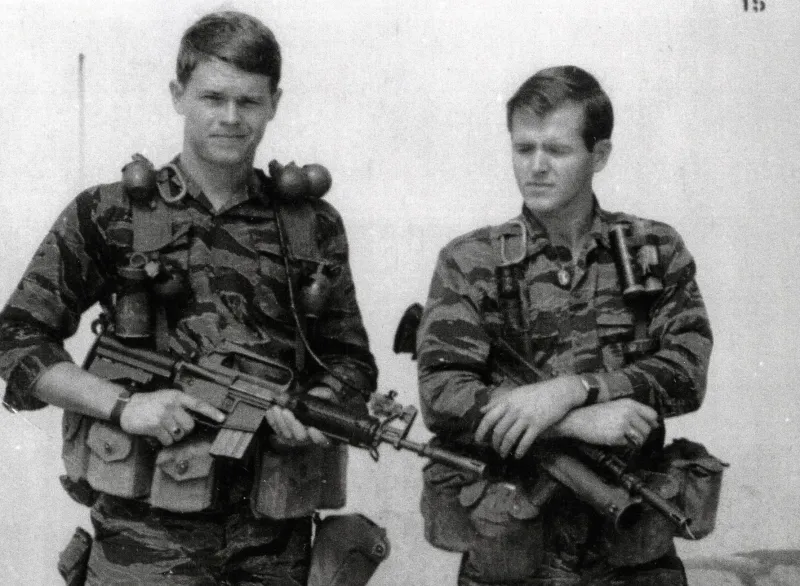
Initially adopted by the USAF as the GAU-5/A, the XM177 would start to see use in the Vietnam War, with Colt keeping a careful eye on user reports on the rifle’s performance. The Army would put in an order in 1966 for a few of the Model 609 rifles, giving them the designation of XM177E1. A later modification yielded a lengthened barrel from 10” to 11.5”, allowing for the mounting of new prototype hardware like the XM148 grenade launcher, yielding the new Model 629’s and 649’s. The US Army would place another order for a limited 500~ of the Model 629, giving it the designation of the XM177E2 to differentiate it from the earlier E1. Reports on the rifles were positive, but colored negatively with issues such as reliability, long range accuracy, fouling due to the moderator tending to trap powder in it and the aforementioned tracer issue. Colt would work up a full improvement package for all XM177’s in service and propose it to the US Armed Forces. A six month program costing $400,000 to analyze the problems and propose fixes, and then later an amended 29 month long study costing $635,000. Both were rejected as it was late 1968~ at this point and the Vietnam War was winding down.
The Army would say no.
The Air Force would make their own improvements themselves.
From Snub to Mid-Length
Colt would take its various rework proposals home and develop them further into a new breed of CAR-15’s. Their solution to the problem was a longer barrel, around 14.5~ in length. This ditched the need for the XM177’s clunky moderator, and given how long that moderator was, gave this new rifle around the same length as well. They’d fit it with a standard A1 birdcage and develop the Colt Model 653. Alongside three other models depending on if you wanted a forward assist or a fixed stock, because what is Colt without weirdly elaborate model versions. This would see limited purchases by the US Army as well as nations like Malaysia and the Philippines but as they prepared other models, they’d hear of the GUU-5/P.
Remember how the Air Force bought the GAU-5/A?

Well they found that short barrel to also be a problem, and began a program of modifying them over time. They’d also do a 14.5~ barrel , initially in 1-in-12 twist rate but would add a step in it to still allow the mounting of a grenade launcher and having enough length to mount a bayonet if need be. This was found to be much more useful as an in-general rifle for base security and would begin replacing most of their 5/A’s into 5/P pattern rifles. There would be a later revision but that’s post the creation of the M16A2.
In the late 1970’s, the USMC would request Colt to give them an improved version of the M16A1 given combat experience from Vietnam as well as desires to standardize on other equipment within NATO. All the way back in 1970, NATO held a trial for a new standardized cartridge to fit in with 9×19 Parabellum and 7.62 NATO, going between the XM777 and SS109 loadings of 5.56×45 alongside the British 4.85x49mm and the West German 4.7x33mm caseless ammo. SS109 was chosen as the new standard for 5.56 within NATO, and after decades of shrugging at the concept, the US Military decided to finally bother standardizing properly. The upgrades that Colt did would develop into the M16A2. A 1-in-7 twist rate barrel, made thicker beyond the front sight post to resist bending and distribute heat better. The rifle was given a modified rear sight system, allowing for fine tuning of ranges, alongside the replacement of full auto with 3-round burst. The front flash hider was modified to now be closed at the bottom, to both make it more able to distribute recoil force down and to annoy everyone at the indoor range. And the furniture was swapped to a modern Zytel plastic instead of the M16A1’s thin resin, a longer stock and round handguards. Thus the new rifle was born, adopted by the USMC the same year and adopted by the US Army in 1985.
These upgrades would also be shared at Colt.
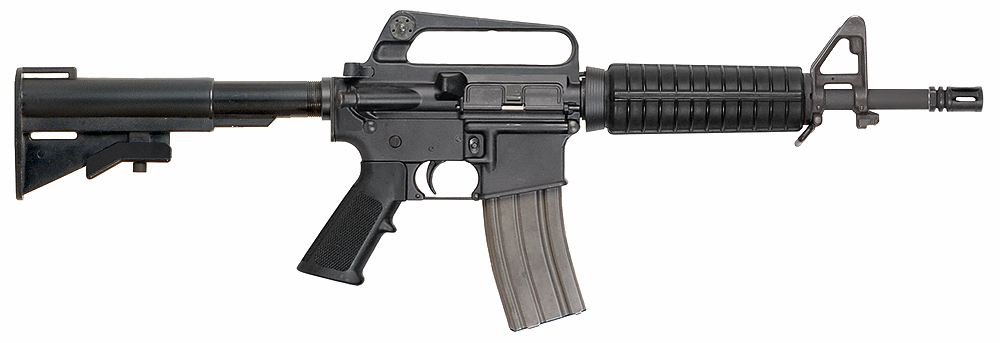

With the A2 came the rise of modified forms of the CAR-15 to fit this pattern, as well as adopting a stepped barrel to allow with the mounting of the M203. These new versions were the Model 723 and 733, with a 14.5~ barrel length and a 11.5” barrel length respectively. These would put the XM177 style CAR-15’s out to pasture and come in a wide variety of versions as the M16’s upgraded from the A1 to the A2. Artifacts like A2 upper receivers and modified barrels would carry over, especially as the military was taking more interest in the concept of these two rifles.
This entire time, the various Special Forces groups of the US Military were still reliant on the Vietnam vintage XM177’s, CAR-15 variants or in some cases even the Korean War vintage M3 Grease Gun or M2 Carbine. These guns were worn out, and while they could keep buying the new CAR-15 variants like the 723, 727 and 733, they wanted a new design and fast. The US Army Armament Munitions Chemical Command would assist by developing a M855 capable XM177 as a stopgap, while the project for the new “XM4” was in creation. The project would slowly form around using as many M16A2 components over the A1 that was used by both the original XM177’s and the various CAR-15 variants in service at the time. The next year in 1984, the US Army would approve development of the rifle properly, and the XM4 would be created.

In 1985, 40 prototypes were to be created at Picatinny Arsenal in New Jersey, a place that will become important later on. These prototypes would be turned over for more extensive testing throughout the year by both the US Army and USMC. Initially, the US Army would pull out of the project but the Marine Corps took the bill and finalized the project. In 1987, the M4 Carbine entered limited adoption by the US Marine Corps, with an initial order of a withering 892 units. A slow start, but things were to change. The same year, US SOCOM was formed and began looking into plans to reorganize and unify the various arsenals of America’s Special Forces Groups. A course correct after the failure that was Operation Eagle Claw in 1980, and a group that would see a trial by fire as soon as it was created.
In Somalia.
Nothing Takes Five Minutes
In 1991, the United Somali Congress would succeed in a plan they had carried in their hearts since the adoption of the M4 in 1987. The overthrow of the Siad Barre regime in Somalia. Barre was a former member of the Somali gendarmerie who had seized control of Somalia in 1969, establishing the nation as a marxist-leninist republic and aligning himself firmly with the Soviet Union. This relationship would collapse in 1977 with the Ogaden War, a conflict that pitted the Soviet backed Somali Democratic Republic against…the other Soviet backed state of Ethiopia which was controlled by the Provisional Military Administrative Council. The Derg. Fighting over the Ogaden region of Ethiopia, this would be three quarters of a year of violence for the Somalis and Ethiopians. While initial engagements were in the favor of the more organized Soviet equipped Somali Army, the Soviets and Cubans would supply the Derg with aid instead. The USSR had an interest in the up and coming Derg officer Mengistu Haile Mariem, and wanted to groom him into another Soviet aligned state.
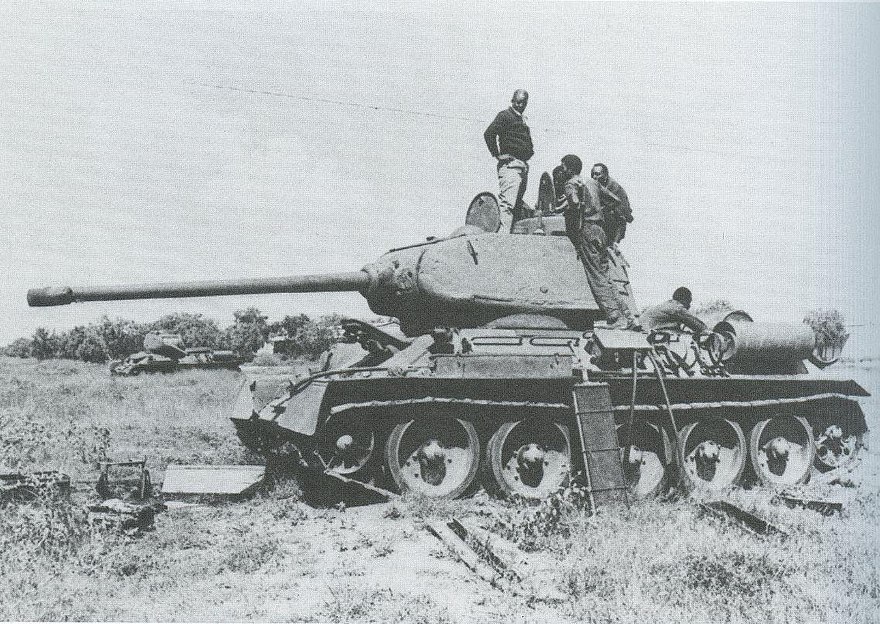
To that end, they chose a new ally over a former one and supplied the Derg with equipment, advisors and crucially air support. By the end of the war in 1978, the Somali Army was annihilated. A third of the standing army had died in the conflict, alongside half of the highly trained Somali Air Force. The regime was destabilized by the result, and while Barre himself would switch to United States alignment, it wouldn’t stop the discontent from building. Factions, based both around ideological lines as well as the old clans of Somalia, would begin trying to fight back against Barre. A coup attempt the month after the Ogaden War ceasefire was signed was put down, conspirators shot and discontent still building. Even worse was Barre’s revenge against those same clans, initially going after the Majeerteen who were assumed to be involved in the coup, before going after the Isaaq. Barre would commit a brutal reprisal, openly shelling Isaaq majority cities such as Hargeisa and leading to 800,000 Isaaq civilians to flee into Ethiopia and killing anywhere from 50,000 to 200,000 Isaaq’s in the process. To Barre, he had dropped his socialist act and returned Somalia to a clan defined age that would continue for the rest of the decade until the worst came to light.
The end of the Cold War.
With foreign aid gone, the importance of Somalia as a stronghold to counter any aggression in the Gulf of Aden was gone. Barre’s constant drip feed of American military and financial aid dried up, and the Derg opened their own floodgates to whichever resistance group asked nicely. Those same groups he had tried to shut down began to rise up in open rebellion, and the small rebellions would catch up into a civil war in 1991 with Barre being overthrown, the Somali National Army disbanded and a void opened up in Somalia. In its wake, the vacuum would have the various rebel groups turn against each other, and in the new decade, came a new force to solve the issues. The United Nations. The UN Security Council would pass two resolutions that’d lead to the creation of the United Nations Operations in Somalia, or UNOSOM. These operations would initially be intended to distribute aid and technical support to create a proper government agency within Somalia to fill the void that the Barre regime had left behind.
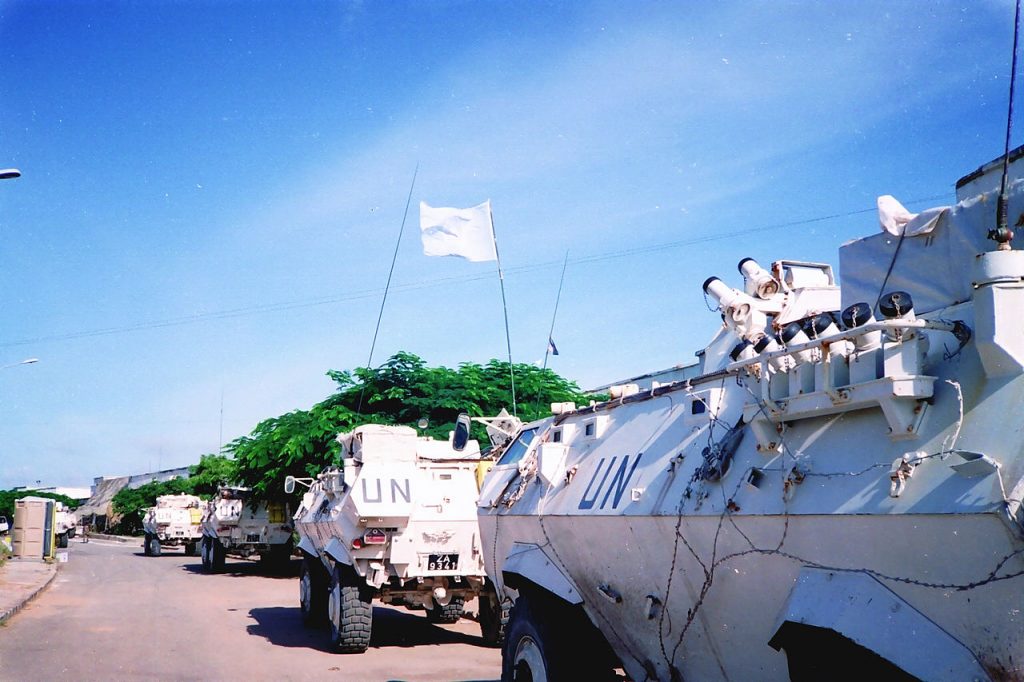
Ceasefires were ordered between the various warlord factions, and the UN would mediate talks. But the talks never went anywhere with constant bickering, and the ceasefires never held. Even worse, humanitarian aid shipments were being raided by the warlord factions, and the UN attempts to get more garrison troops fell on deaf ears. Except one. The US. General Mohammad Farah Aidid, leader of the United Somali Congress was emboldened by these successes and began calling for the removal of all UN peacekeepers from Somalia. In response, the Security Council passed Resolution 794, creating the Unified Task Force or UNITAF. This would initiate UNOSOM II, a renewed UN mission into Somalia and Operation Restore Hope. Create a new federalist government tying the now 18 different Somali factions together, restore a government order, re-establish representative democracy and rebuild the infrastructure torn apart by the now half a decade long conflict. Noble goals. Just bad execution.

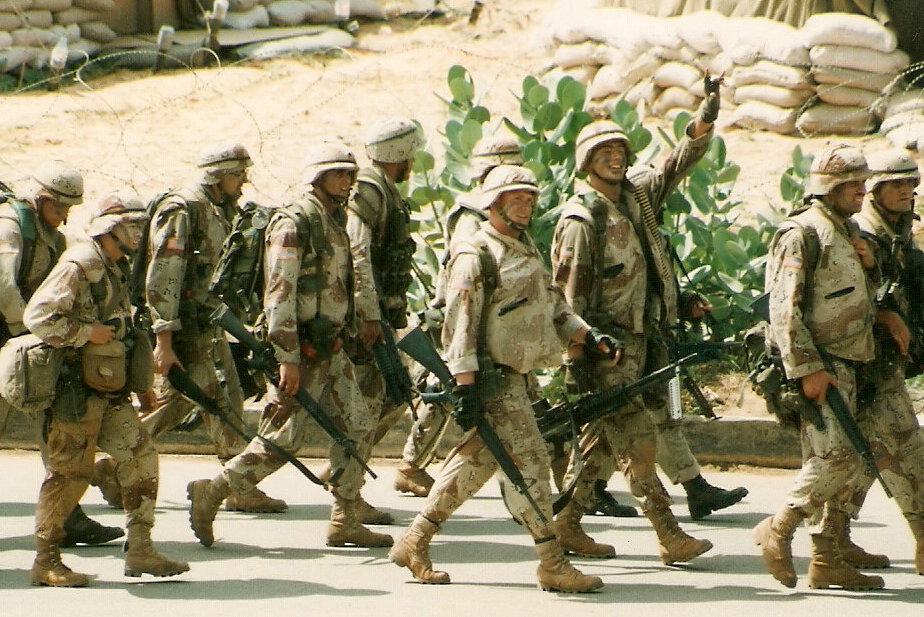
Initial problems mounted with the UNOSOM mission as they began investigating the United Somali Congress and its leader Mohammed Farrah Aidid. A small contingent of Pakistani UN soldiers was sent to investigate an arms cache and was met by an angry mob, and when they went to fully investigate the group of 24 soldiers were killed. The escalations continued with the passing of Resolution 837, allowing UN forces to engage USC affiliated militias and restore order. Which they did by bombing a house during a clan meeting on July 12, and when journalists went to film the wreckage, they were beaten by an angry Somali mob. The UNOSOM forces had now burned the bridges they had crossed with the Somali public, angering them to their presence and creating the Somali National Alliance in response with Aidid at it’s head. So in response, UNITAF would prepare their own operation, a strategic strike to not only reaffirm UN control but break apart this SNA group. It would be dubbed Operation Gothic Serpent.
In response to the demands by UN members to seize Aidid as well as a few bombings of US Army vehicles around Mogadishu, President Bill Clinton authorized the creation of Task Force Ranger. This was a collaboration between Delta Force and 75th Ranger Regiment to hunt down Aidid. When an informant leaked a possible location where Aidid was to meet with higher ups in the SNA, the raid would be planned out. Delta would helidrop into the area, seize Aidid and any SNA members they could and then reconnect with 75th Rangers for exfil. And if you know your history, you know this plan DIDN’T go well.
Beyond the obvious problem that Task Force Ranger did not take control of Aidid but only associates within the SNA, but their exfil would be barraged constantly by Somali militiamen operating RPG’s from the various rooftops of Mogadishu. Two specifically were lost, and their crews surrounded, defending until the end. The Rangers and Delta Force involved in the actual raid would be encircled by Somali militia, intending to bomb them out but electing to not launch mortar strikes to not hit civilians. Heavy fire from the Americans combined with a rescue convoy hemmed by the 10th Mountain Division would break the encirclement, rescuing the group. At the end of the day, 19 American lives, 25 Pakistani and 1 Malaysian were lost, and 94 were wounded. The Somalis lost a combined 315 members, both militia as well as civilians with upwards of 215 injured. While Task Force Ranger had met their mission requirements with minimal losses considering how outnumbered they were, Gothic Serpent was the straw to break the camel’s back.
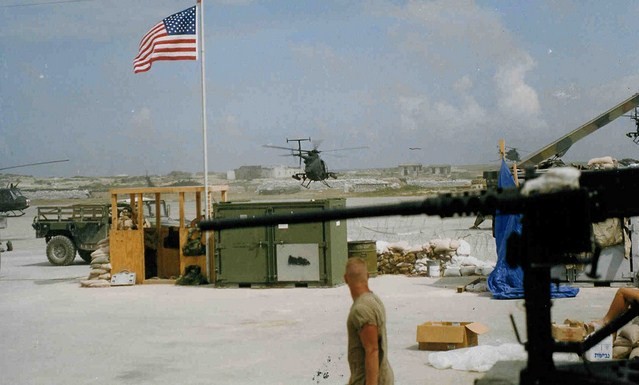
No mission would be held to recover the bodies of the various crewmen of both helicopters, and in the wake of the battle news crews would descend on Mogadishu and film Somali crowds parading the bodies. The image of that sank hard into the American populace, who began demanding an American pullout of UNOSOM. That combined with the Somalia Affair, where members of the Canadian Airborne were caught beating and torturing a Somali teenager to death would destroy all public opinion of UNOSOM II. In October, Bill Clinton would appear to the American public and say that he had ended “proactive policy” and American soldiers would pull out in 1994. UNOSOM II collapsed in on itself, with minimal aid beyond food and medicine from certain members. The reverberations of it would ripple into the Somali Civil War continuing as long as it did, as well as President Bill Clinton’s lax response to incidents like the Rwandan Genocide. It would bring many changes to the American High Command, including everything from uparmor kits for the MH-60 Blackhawk and increased usage of door gunners to the first of upgrade packages to the HMMWV to provide more protection for occupants and gunners, and even down to the rifles and equipment used there-in.
The M4’s adoption was perfectly timed.
Sir, This Is My Safety
In the aftermath of the Battle of Mogadishu, the various survivors were interviewed to discuss any negligent points in their equipment and tactics there-in. And there was a clear divide that cropped up very fast in regard to mainline arms. For the Delta Force mostly equipped with the motley mixture of CAR-15 variants, they had no issue. But the 75th Rangers had many issues with their long M16’s in the tight streets of Mogadishu. Interest in more compact rifles was increasing, and the M4 was that rifle, and so the Army would take more interest and order more to replace the M16A2. This would be put to the test again with a UN KFOR mission to Kosovo, and no I will not go on a tangent this time. But it was the first combat engagement with the new M4, and soldiers seemed to like it. So, they’d begin more adoptions. As well as modernization.
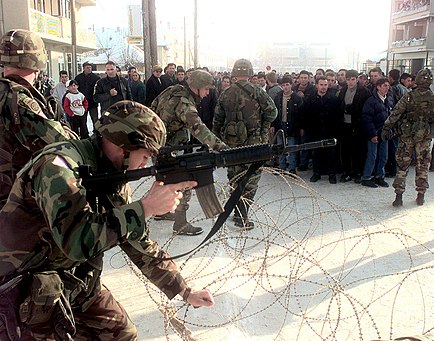
The original fixed carry handle XM4 and early M4’s were replaced by new models fitted with a removable carry handle and brand-new picatinny M1913 rails. These would be followed up by the M4A1, a series of product improvements made to modernize the M4 in response to both testing of the rifle as well as user reports from Gothic Serpent. This included a new higher profile barrel, improved feed ramps, the swap from 3-round burst back to full auto and an ambi selector lever. While initially intended solely for US SOCOM, to finally unify their AR variants in 1994, it would begin drip feeding it’s way down to the average soldier especially as the Global War on Terror began to take hold and the same issues the Rangers had in Somalia cropped up in places like Mosul and Fallujah. And at the same time, there was another bit of consolidation. Albeit now with equipment.
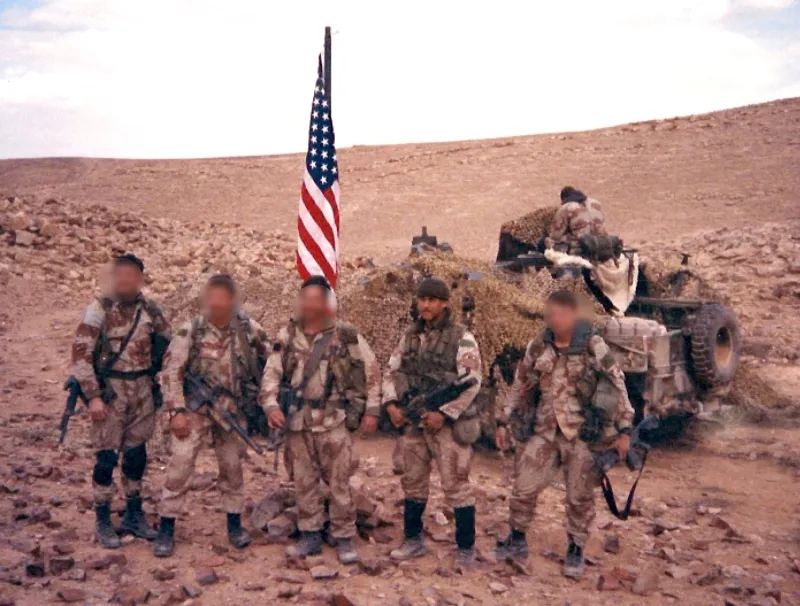
US SOCOM prior to the M4 project did operate a myriad of CAR-15 variants, as I’ve said a few times already. They did also experiment heavily with equipment as well, being some of the first major members of the US Military to experiment wholesale with features like weapon lights, red dot sights and extended magazines. For the most part, these components were allowed but issued wildly to divisions, and so the “Gordon Carbine” style of CAR-15 varies based on era, equipment and user preference. While it was instrumental in applying these modern technologies to actual combat usage, it was very disjointed, relying on a myriad of oddball rifles that were now beginning to be replaced by Colt in production by their new export pattern of M4 Carbine. Plus, the various equipment options were becoming outdated as the market began to introduce newer and improved models of everything from red dot sights to laser/light combination units. As such, US SOCOM would generate a new package deal that would incorporate a small but sizeable amount of modular components to the M4A1 platform rifle to upgrade the weapons capability of their operatives but also give them a unified platform after so long. This would become the Special Operations Peculiar Modifications.
SOPMOD.
While the concept for SOPMOD is about as old as the XM4, it would only be rolled around 1994 to begin consolidating the various wonky equipment of USSOCOM into something concise. It would be an effective pool of equipment for operators to use. And as such would begin modifying the new M4A1 as they saw fit. This was aided a year later with the adoption of MLE-STD-1913 standard rails. No more fiddling with wonky sorta-similar but not really Weaver stocks. With the new M1913 or “picatinny” rails as they were nicknamed from their origin at Picatinny Arsenal, they now had a standard rifle and standard attachment method upon which to build their rifles. And so they’d begin opening up bids to a variety of companies to help fill the SOPMOD roster.
Reed Knight and the Block System

Knight’s Armament Company was set up in 1982 as an in-general machine shop in Titusville, Florida by one Reed Knight. Knight was a protege of Eugene Stoner, collaborating with the man repeatedly and sharing his interest in modern rifle development. KAC wouldn’t get super involved in the US Military until 1989, as the story goes Reed Knight watched photos of US Special Forces in Panama and saw the taped maglites on their rifles. Thinking it was a bad idea and someone could do better, he would begin work on what would later become the Rail Interface System or RIS. This, combined with his submission of the KAC suppressor to the Mark 23 trials that were going on around the same time would allow Reed Knight to anchor his ship close to the proverbial dockyard of USSOCOM and the US military. Without those two, you don’t get later productions like the SR-25 or the Knights Armament Company machine gun projects.
The RIS would be included in the SOPMOD program, alongside the now iconic broomhandle KAC foregrip and the KAC BUIS. Orders for them began in 1994, and later saw the adoption of the RAS Rail Adapter System in 1997. With this, SOCOM could look into other new features such as lasers, flashlights and IR designators, leading to fellow KAC collaborator Insight Technologies and the PEQ-2 and later PEQ-5. There would also begin testing in a wide variety of both red dot optics as well as scopes, unifying around a few basic patterns. Trijicon would win the red dot requirements with the CompM2 adopted as the ECOS-N red dot as well as the RX01. They’d also choose the TA01 for adoption as the “Advanced Combat Optical Gunsight”. The first ACOG. There’d also be a few other variants including things such as the PVS-17A NV system, the KAC QDSS suppressor mount flash hider, and the iconic M203 bloop tube. And thus, the modern M4A1 was born. And as newer parts were introduced, they’d drip down into the various equipment rosters of the standard infantry. And soon the various SOPMOD components would see service in places like Iraq and Afghanistan.
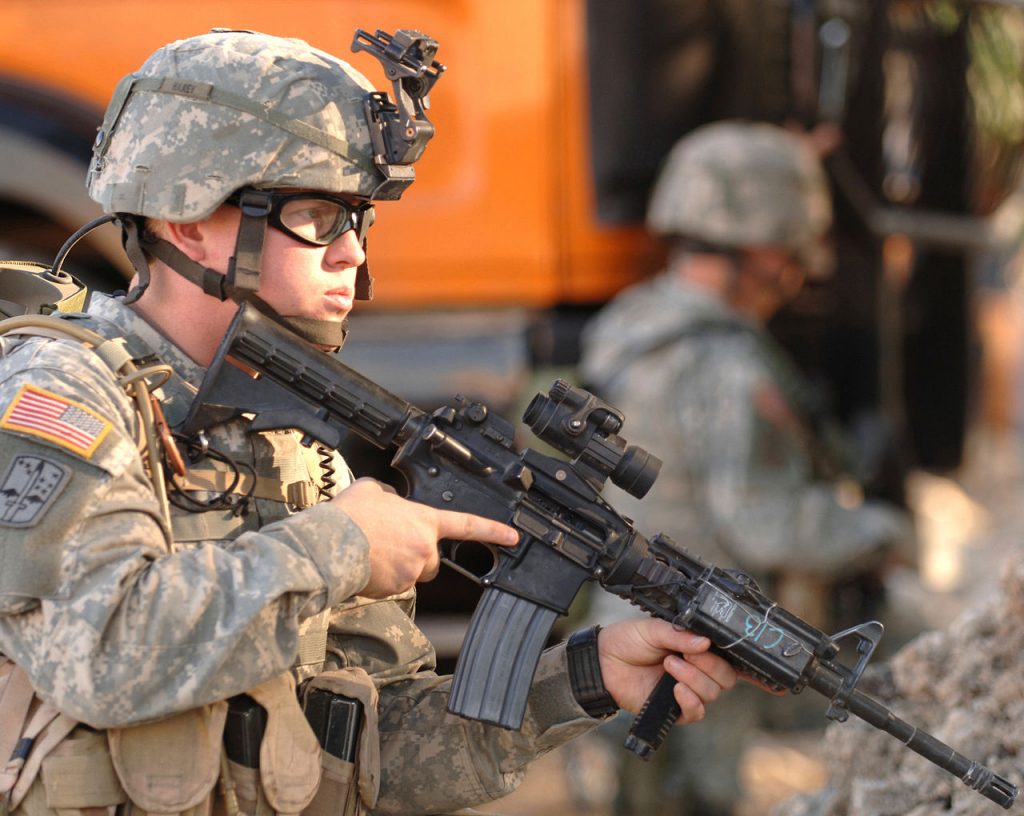
By 2005, the M4 had finally displaced the vintage M16A2 in the hands of mainline US Army field personnel and would see larger use during the ongoing wars in both Afghanistan and Iraq. In 2009, the Army would take full ownership of the M4 design, and begin working on a variety of improvement packages following the mediocre flop that was the XM8 project. While some of these were as lofty as electronic round counters straight out of Aliens, what would end up coming down was a plan to begin replacing the standard M4’s in service with the M4A1, as well as larger scale adoption of the RAS and RIS systems and the SOPMOD equipment into large scale use. A year later, they would reward Colt with a contract for 12,000 new rifles, as well as conversion kits for the M4 to make them M4A1 standard.
Combat in Fallujah would also cause the USMC to rethink their strategy. While they prided themselves on individual marksmanship and had eschewed the M4 in favor of their own M16A4 program, the long length had proven detrimental yet again. So in 2007, they would begin issuing NCO’s and other officers M4A1’s instead of M9’s, and broadening this adoption until 2015 when a majority of members of the USMC were calling for full-scale adoption of this rifle. To this, they would finally acquiesce. Before deciding to go down a path of mass adoption of the M27 IAR, a warmed over HK416 that had been adopted as a light automatic rifle to supplant the M249 in USMC squads. While they claim to have interests in replacing all of their M4’s with the IAR, only around 14,100 have been delivered. So it’s debatable if it’s been fully adopted or not. The USMC and their constant push to be special.
Back in 2002, the Block I program would be followed up by the Block II, creating both the Special Purpose Receiver and the Close Quarters Battle Receiver and creating the Mk. 12 SPR and reviving the Model 733 with the flat-top Colt Model 933 being adopted as the Mk. 18 Mod 0. Further modification of M4’s continues with flat top Block II’s being used interchangeably in service with US Special Forces. In recent years they have created a Block III, although it’s only known as the Upper Receiver Group, Improved or URG-I. Primarily used by US Army Special Group Command, it has seen the use of MLOK, Surefire 4-prong flash hiders and other improvements to the design. Over this entire history, there have been many attempts to replace the M4 series of rifles in both size and prestige. With projects like the OICW, the XM8 and the current NGSW trials all aiming to displace this rifle platform as standard. However it seems to be that the US Armed Forces aren’t giving up on the classic M4 just yet.
The Block I
So, this rifle build. This is my explicit side project I worked on last year to make my own M4A1, to try and understand why this rifle is so popular. I wanted to make the most 2003~ M4 possible, and in doing so I can relay the same information to you on how to do so. So, let’s get started.
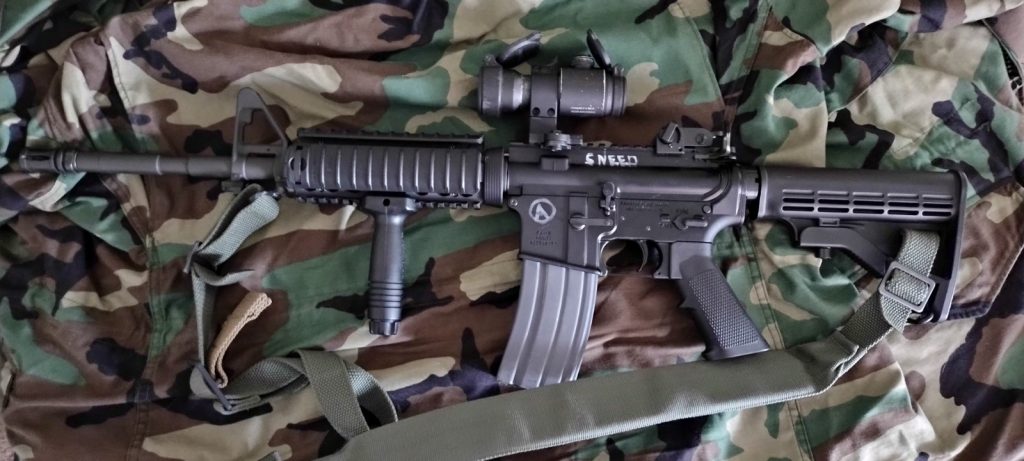
This rifle is a basic AR-15 pattern rifle, firing from a multi-lug rotating bolt operated by direct gas impingement from a port on the barrel. It then recoils down a buffer tube assembly that pokes out of the back of the rifle before returning home, feeding a new round in the chamber as it does so. And it uses DI because I’m not a mouthbreathing sycophant who wants to start an internet argument in real life at the range explaining how a piston is better, I don’t care because this rifle was built not to care. As such it has the most basic of modifications. A KAC RIS handguard, a few KAC rail covers, a KAC foregrip, a CompM2 subbing in for an ECOS-N, a MaTech BUIS sight, a Blue Force Tactical Sling and nothing else. Same 6 position buffer tube, same A2 pistol grip, same stock trigger, magazine release, bolt release and forward assist. This is the definition of a rack gun.
Every time I look at it, my brain automatically goes “Optimizing Shaders” and playing the MEC theme from Battlefield 2.
And now you’re going to be thinking of that too.

At the rear we have standard AR-15 everything, including a 6 position buttstock and a classic M4 collapsing stock. A little rattly, a little tinny and it makes one of the most overly mechanical feelings when you shoot it, but still fine. If it was any other rifle, I would probably go for something like an A5 buffer tube with either an H1 or H2 pattern of buffer in it, but again, base model AR, base model parts. This lower assembly is just a PSA Stealth-15 lower that I got cheap with a daily deal. I could use an Aero or an LMT, and I know that no one can or will care about that choice. No one will fawn over me and praise me as a new deity because I used a fancy lower on a poverty M4 I built for funsies. As such, all the other parts down here are standard.
The trigger is a 6 lb Mil-spec which is a single stage generic trigger. One of the most underrated aspects of the modern M4 or any AR is that trigger. Is it boring? Yes. Can it be improved? Yes. Is it one of the most solid basic triggers in the world? Absolutely. AK owners cry in response to how simple that trigger is, and everyone else copies it. Because it’s good. The selector switch exists, as does the bolt release and magazine release. The mag release exists for you to hit with your forefinger and drop your mag directly on the floor, and the bolt release exists for you to have an argument about how you’re supposed to hit it. The winning move is to do all of the techniques at random, because it’s fun.
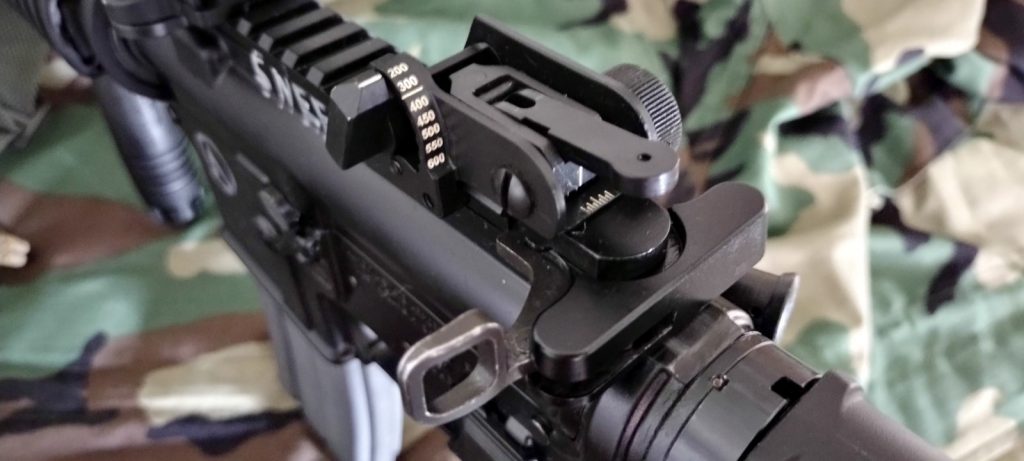
Up on the top of the receiver, we have the funny charging handle. It’s non-reciprocating, it exists mostly for you to use once or twice and then forget is a thing until you stovepipe a round. I have a funny extended latch from my initial intentions to make the MW3 M4 before I gave up. I think it looks nice and it’s a decent way to get a better grip on an AR-15 charging handle without going for a Radian or BCM charging handle. For the look, yknow?
Speaking of looks. It’s time to mention sights. And the Dr. Jekyll and Edward Hyde situation on this rifle. You see that BUIS and we’ll get to him, but first let’s talk about the nice thing. The Aimpoint.

The CompM2, here represented by a surplus one you can find by the utter truckload on Ebay, is the sight you almost expect from a Block I equivalent rifle. It’s either this, an actual M68 CCO or an ACOG. And on a CCO mount like this, a LaRue model that allows you to get a good lower 1/3 cowitness on the front sight post. No absolute like you would with EOTech’s on rifles like this.
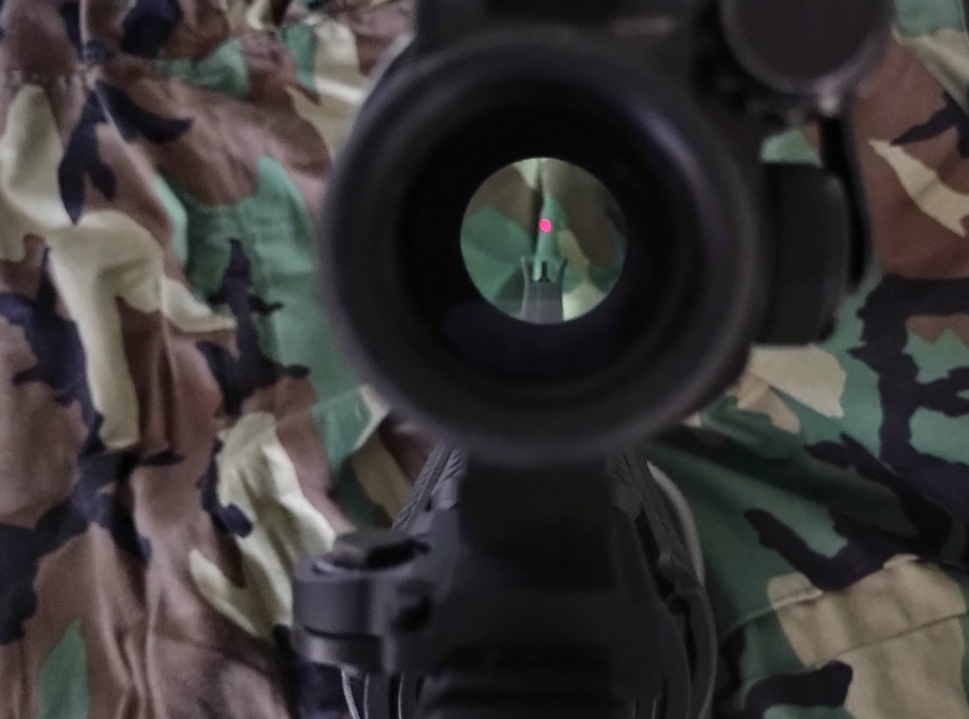
Despite the age and overall rough exterior of this optic, it’s still a classic Aimpoint with very clear glass and a crisp reticle, with a large amount of settings that you can spin through with the now iconic rear adjustment dial for any levels of brightness, from “NV usable” to “Finding out you might have astigmatism the hard way”. It’s a solid red dot, one of the most iconic in the modern era and the one that really helped establish Aimpoint as we know them today. If you don’t want as junky looking of a Red Dot, using an Aimpoint PRO is also applicable. But if there’s one thing you must not copy, it’s the rear sight.
It sucks.
The Matech BUIS system. This is the milspec style of BUIS seen on most modern M4’s, it came with this upper and I’ve kept it for the sake of the appearance. But I will say flat out, it’s terrible. Bad? No, there’s arguably worse out there but this is still bad. In short, it’s a plastic and metal flip up sight that goes from 200 yards to 600 via this massive rotary dial on the side. It also is windage adjustable with this knob on the right. All of this is good, and despite being plastic, these are fairly robust. At least at first. There’s two main issues. For one, the sight is kept up by a wimpy little spring, and that spring tends to wear out over time. I don’t know the exact rate at which it loses tension, but it’s not ideal and it leaves you with an iron sight that needs a blue pill to get it back up for function again. The other issue is the paint job. It’s all nice and shiny and black which makes it look slick to anyone who doesn’t know any better. That extends.
To the goddamn aperture itself.
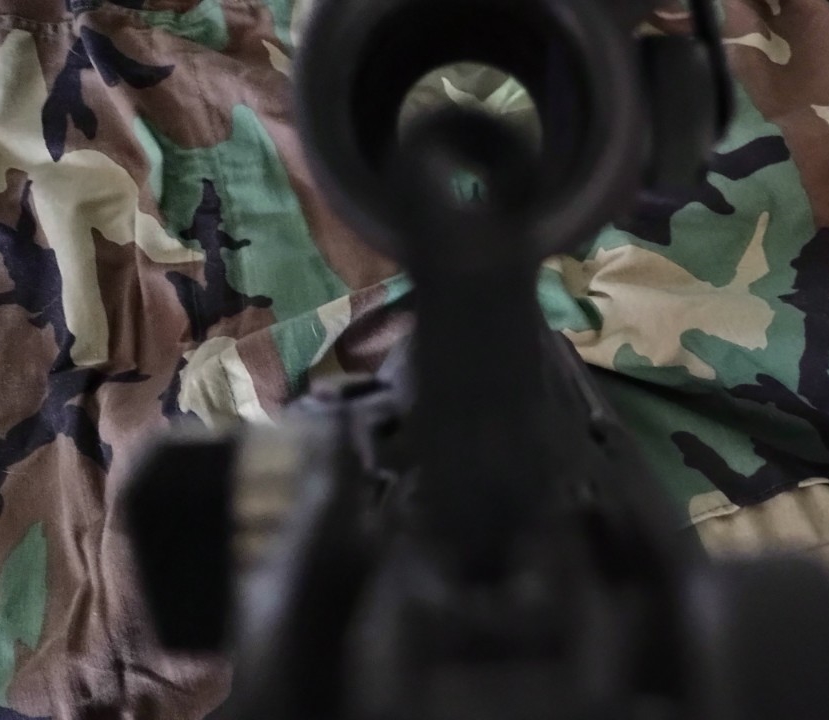
There’s a reason every other aperture has a flat but checkered matte coating to them, from the M1 Garand to the KAC BUIS. It means it doesn’t get light in it, that shines and utterly BLURS the sight picture of this assembly. Oh sure, right now inside of a normal room with natural lighting it looks fine, but the second, the very absolute second you get a ray of sunshine onto that eeny weeny itsy bitsy tiny flat black hole, all bets are off. You will have a better time using a straw on scope mounts than using this.
Right, focus. Talk about something normal.
UPPER COMPONENTS, YES.
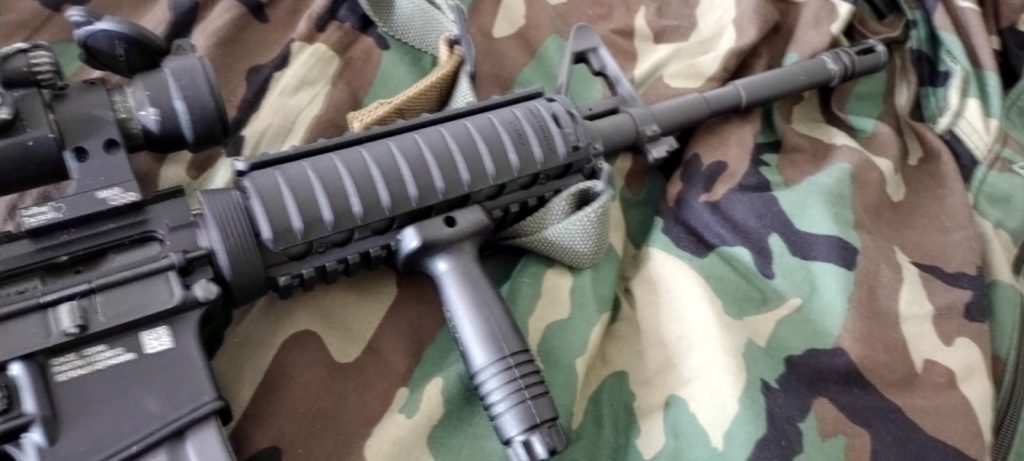
The upper assembly itself is a DSA Arms upper, as part of their weird modern retro line they began a few years back. It’s a retro line for zoomers who don’t remember anything past 2010 and have fond memories of Project Reality. As such they make mostly modern cloner uppers like M16A4’s with a 20″ barrel, a Mk. 18 Mod 0 length upper and two flavors of M4 at both 14.5″ with a free muzzlebrake and a 14.7″ with a pinned and welded A2 birdcage. They also sell all those versions with KAC parts, the RIS and added rail covers. And with a cost coming in at around 500~ for a complete upper when I was looking into it in the midst of pandemic panic buying, I bit. And I must say.
It’s a nice goddamn upper.
What I have is the 14.7″, mostly so I didn’t get my dog shot by the ATF and to avoid having any RSO range killjoys ask me any silly questions. I wasn’t ever intending to suppress it anyway. It’s all decent parts, a 1-in-7 twist rate barrel, chrome lined chamber with M4 feed ramps, a hard anodized mil-spec finish and coming complete with all the KAC goodies and the MaTech rear sight. It’s a fairly damn good barrel, the upper itself is well made, above average and at a price point slightly higher than surplus Colt uppers. Not a bad choice if you want a care-free clone and you don’t mind an extra .2″ of barrel. That combined with a Toolcraft bolt, which I’ll get to later.
It rocks a KAC RIS handguard alongside three rail covers and a KAC broomhandle forward grip. The grand-daddy upon which all other forward grips come from. Freakishly sturdy for being mostly plastic, silly expensive to buy and long enough to be used as both a full-on foregrip, a massive oversized handstop and probably a blunt object for hitting people with if all else fails. It also has three rail covers for that Firearms: Source drip, and no I will not stop name dropping late 2000’s PC games that absolutely influenced me to make this build. Beyond that, we have a front sight post, stepped barrel and the classic A2. Annoying ranges long before pistol builds did.
The Block I in Profile
I feel like this rifle messes with your mind because of how much of a blank pattern the M4 has become on the American market. Any gun store worth its weight in ammo will always have a few generic sporter guns that operate in this same basic form factor. Carbine gas, 6 position stock with a standard buffer tube, usually a 16″ heavy barrel. It’s the default AR for a lot of first time gun owners and it’s a platform that endears itself to no one because of that. It’s a baseplate upon which you slowly customize, and then once you have a hang of things, you sell it and buy something more competent. We’ve all been there. And so you look at something like this and expect something similar, but…
It’s lighter than you think it is.
For the rifle that made the quad-rail popular, this thing is a very nice and lightweight little package for the money. The RIS itself combined with a stepped barrel rather than a full HBAR makes this gun much more pointable and easy to work with than your average Bass Pro Shop AR with a MFT quad rail, and the fact the rail isn’t just straight steel that weighs as much as a small child, it also helps to make this thing not a drag on you as a shooter. Reed Knight popularized the RIS quad rail and he’s the only man to make it not out of depleted uranium.
Recoil is standard punchy carbine gas, never anything particularly exciting but it is noteworthy. Mechanical though, very simple of a push followed by the feeling of the spring decompressing rattling through the buffer tube and the stock itself. All of the M4’s controls are simple, easy and to-the-point, you don’t need to overthink or over complicate any control on this thing. And combined with a Toolcraft bolt, it is a fairly accurate rifle for the money, more-so than you’d expect again considering the price point and overall bog standard construction of it. But why make this?
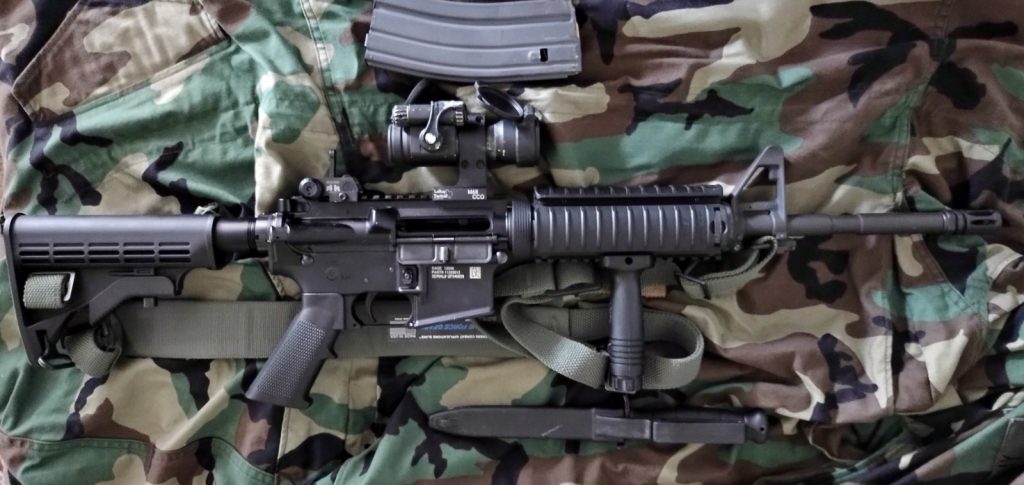
For the past 20 years, the tides of “OH I MUST CLOOOOOOOOONE” have shifted constantly away from just making your own M4 at home. In 2022, the memes are either full retro with M16A1’s and Colt XM177’s or going recently modern with Block II’s and Mk. 18’s. The humdrum M4 is left in the dust relative to those designs, again primarily due to how this rifle’s basic framework of pros and cons have been reused over and over by civilian manufacturers for normal AR’s. You can’t look at this without transplanting something like a Sport II or an AR-556 over top. And that’s why I did it. Like the Glock 17, this rifle is built on a number of fundamental core tenants that have become a default.
Think about it again, all of the modern rifles that try to copy the Block I fail to do so. In 2000, SOCOM developed a rifle that has been grabbed at constantly by many other people. They modified a basic rifle and gave it a reliable and accurate rail system, that was lightweight enough to not be over encumbering while still being accurate and solid enough to allow the mounting of not only foregrips and rail covers, but also weapon lights, laser and IR devices and even grenade launchers. It has a long flat top receiver that allows you to mount a variety of red dots, scopes and optics on it for both daylight and night time use, and it has a variety of furniture components you can modify to your tastes with nothing more than an Allen key and a 5.56 bullet tip at need be. It remains accurate to around 500 yards if you play your cards right, probably even the full 650 yards and it does so while being resilient to all weather conditions. It runs filled with mud, sand, dirt, debris, snow, frost and other fluids you’re thinking of right now that I won’t say but you can get the GIST. The M4A1 is a default rifle, and it is a default because of how it functions. It is such a mathematically square and centered rifle that it boggles the mind. This thing is not simply a standard rifle in 2022, it is THE standard rifle that all nations and groups strive to get to. It is so inherently solid that it has refused to be replaced.
This is a Casio watch, it is a Toyota Corolla, it is a generic toaster you buy at Wal-Mart, it is a no-name drill press you bought on Craigslist. It is a platform that works primarily on reliability and doing its job to a point of functional stasis. A well oiled part of a machine, no matter what that machine may be. The M16 founded the AR-15 action and rifle series, established its credibility within the US Military and abroad, but it was the M4A1 that took it to the next level. It took the modifications and engineering of decades and gave it a solid platform upon which one can do anything. It can be spun more ways than Apache by the Incredible Bongo Band, a riff that can be ripped again and again and again. Make it a mid-range DMR, make it a close range hair singing “get kicked out of the indoor range for three full mag dumps” powder burner, go stupid heavy and overbuilt, make a Block II with more rail space than rifle and then use it to beat a man to death. You probably can, and it will probably retain zero.
Try doing that with a G36.
With the Block I, it opened the door for the modification of the AR platform and improving it beyond the initial work done by Eugene Stoner and Jim Sullivan. It allowed that, and by being so boring it has allowed itself to be modified again to improve every aspect of it, and that fact will probably keep it going forever. Modified endlessly and perpetually into newer and newer roles no one thought possible.
We make jokes about seeing M2’s on Mars.
I’d put 20 dollars down now we’d have M4’s on Mars.
The Space Force will take the first intergalactic conflict’s life with a Block I M4 modified to be used in zero gravity.
And God bless ‘em for it.
